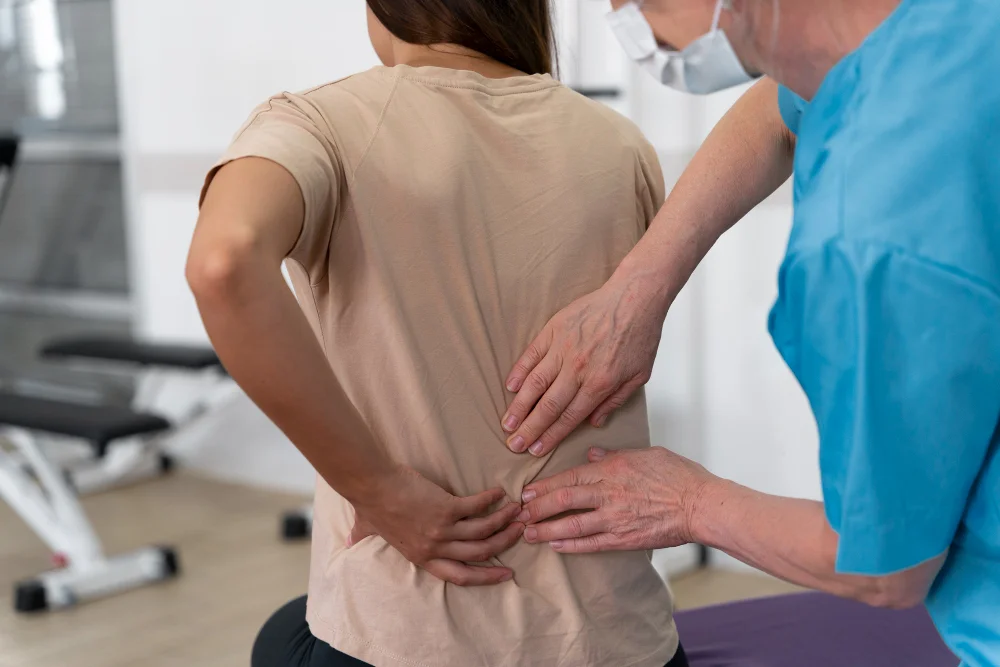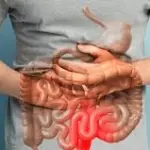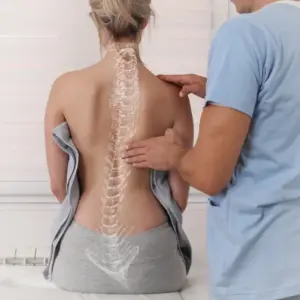Advanced Total Disc Replacement Surgery for Pain Relief and Mobility
Total Disc Replacement relieves back pain, restores motion, and improves spine flexibility with advanced surgical precision.

Total Disc Replacement
Total Disc Replacement (TDR), also known as Artificial Disc Replacement, is a surgical procedure that replaces a damaged spinal disc with an artificial one to maintain motion and relieve chronic back or neck pain. Unlike spinal fusion, which eliminates movement by joining vertebrae, TDR preserves flexibility and natural motion. It’s typically recommended for patients with degenerative disc disease or disc injuries that cause persistent pain and nerve compression. Using advanced materials like metal and medical-grade plastic, the artificial disc mimics the natural disc’s cushioning and movement. This procedure significantly enhances mobility, reduces pain, and offers long-lasting spinal stability.

Early Detection Saves Lives
Early detection and treatment are crucial for improving the chances of survival. If you notice any concerning symptoms, consult a healthcare provider immediately.
Signs and Symptoms
Chronic Back or Neck Pain
Persistent pain in the cervical or lumbar region due to damaged or worn-out discs.
Radiating Pain
Pain that spreads down the arms or legs, often caused by nerve irritation.
Stiffness
Reduced range of motion or flexibility in the spine.
Muscle Weakness
Difficulty lifting objects, walking, or maintaining posture.
Numbness or Tingling
Pins-and-needles sensation in the hands, arms, or legs.
Pain After Sitting or Standing
Discomfort that worsens during prolonged postures.
Loss of Height
Gradual disc degeneration may lead to a compressed spinal column.
Reduced Daily Function
Difficulty performing normal activities like bending, driving, or exercising.
Blood in Urine
Hematuria - pink, red, or dark urine, the most common symptom
Frequent Urination
Feeling the need to urinate frequently, even when bladder is not full
Painful Urination
Experiencing pain or burning sensation while urinating
Back or Pelvic Pain
Pain that occurs as the cancer grows and spreads
Unexplained Weight Loss
Significant weight loss not related to diet or exercise
Fatigue
Feeling unusually tired or weak without a clear cause
Meet Our Expert Total Disc Replacement
Risk Factors
Smoking
Smoking is one of the leading causes of bladder cancer. Chemicals in tobacco smoke can damage the lining of the bladder, increasing the risk.

Gender
Men are at a higher risk of developing bladder cancer than women.

Chronic Bladder Infections or Inflammation
Conditions such as bladder infections and long-term bladder inflammation can increase the risk.

Exposure to Chemicals
Prolonged exposure to certain chemicals, especially those used in the dye industry, rubber production, and chemical manufacturing, increases the risk.

Age
Common in adults aged 30–60 due to disc wear and tear.

Degenerative Disc Disease
Progressive disc deterioration over time.

Previous Spinal Injury
Accidents or trauma causing disc damage or herniation.

Genetic Factors
Family history of early spinal degeneration.

Poor Posture
Chronic slouching or improper sitting positions strain the spine.

Obesity
Excess body weight accelerates spinal stress and disc degeneration.

Smoking
Reduces oxygen supply to spinal tissues, hindering disc health.

Occupational Hazards
Jobs involving heavy lifting or repetitive movements increase risk.

Sedentary Lifestyle
Lack of movement weakens spinal support muscles.

Total Disc Replacement
Diet and Nutrition
Prevention
Diagnosis
Key Services
Key Facilities
Nutrition plays a key role in maintaining healthy spinal discs and ensuring recovery after surgery.
- Protein-Rich Foods: Essential for muscle and tissue repair — include eggs, fish, lean meat, lentils, and soy.
- Calcium and Vitamin D: Strengthen bones and support disc structure — found in dairy, leafy greens, and sunlight exposure.
- Omega-3 Fatty Acids: Reduce inflammation and promote joint health — sources include salmon, flaxseeds, and walnuts.
- Vitamin C: Aids collagen production for spinal ligaments and discs — available in citrus fruits and bell peppers.
- Magnesium: Helps with muscle relaxation and bone strength — found in almonds, spinach, and avocados.
- Hydration: Keeps spinal discs hydrated and resilient.
- Avoid Processed Foods: Limit sugar, caffeine, and alcohol as they promote inflammation and slow recovery.
- Fiber-Rich Diet: Prevents constipation, which reduces strain on the lower back post-surgery.
While disc degeneration can’t always be avoided, preventive measures help maintain spinal health and delay disc wear:
- Regular Exercise: Focus on low-impact workouts like swimming, yoga, and core strengthening to stabilize the spine.
- Proper Posture: Maintain upright alignment while sitting, standing, and walking.
- Healthy Weight: Keep body weight in check to reduce spinal load.
- Ergonomic Work Setup: Use chairs with lumbar support and adjustable desks.
- Quit Smoking: Improves blood flow and disc oxygenation.
- Balanced Diet: Nutrient-rich foods promote strong bones and flexible discs.
- Avoid Heavy Lifting: Use correct lifting techniques; avoid twisting or jerking motions.
- Stay Hydrated: Keeps spinal discs plump and elastic.
- Routine Spine Check-ups: Detect early signs of disc degeneration for timely management.
Accurate diagnosis helps determine whether a patient is a suitable candidate for total disc replacement.
- Medical History Evaluation: Review of symptoms, previous treatments, and lifestyle habits.
- Physical Examination: Checks spinal flexibility, reflexes, and muscle strength.
- X-rays: Assess spinal alignment and disc spacing.
- MRI (Magnetic Resonance Imaging): Reveals soft tissue damage and nerve compression.
- CT Scan: Provides detailed imaging of vertebral bone structure.
- Discography: Identifies the specific disc causing pain by injecting contrast dye.
- Bone Density Test: Ensures strong bone structure for holding an artificial disc.
- Neurological Assessment: Evaluates nerve function and sensory response.
- Pre-Surgical Evaluation: Includes blood tests, cardiac screening, and anesthesia suitability.
Hospitals like VS Hospitals offer advanced total disc replacement surgery with cutting-edge technology and personalized rehabilitation care.
- Minimally Invasive Disc Replacement: Small incisions and precision techniques minimize blood loss and speed up recovery.
- Cervical and Lumbar Disc Replacement: Performed for both neck and lower back disc degeneration.
- Robotic-Assisted Surgery: Ensures pinpoint accuracy in artificial disc placement.
- Motion Preservation Surgery: Maintains natural spinal movement, unlike fusion.
- Custom 3D-Printed Discs: Personalized to match the patient’s anatomy for better results.
- Pain Management Programs: Include non-opioid medications, physiotherapy, and nerve pain relief.
- Comprehensive Rehabilitation: Focused on restoring strength, flexibility, and confidence post-surgery.
- Spine Health Education: Guidance on posture, diet, and lifestyle adjustments to sustain results.
- Follow-Up Imaging: Regular check-ups with MRI or X-rays to assess disc positioning and healing.
- Dedicated Spine Surgery Suites: Equipped with advanced navigation and imaging systems for precision.
- Robotic Spine Centers: Offer higher accuracy and lower risk during disc replacement procedures.
- Intraoperative 3D Imaging: Real-time visualization for perfect implant positioning.
- Post-Operative Recovery Rooms: Designed for patient comfort and continuous monitoring.
- Advanced Physiotherapy Units: Provide rehabilitation through exercises, hydrotherapy, and laser therapy.
- Pain Management Clinics: Specialized care to control discomfort during recovery.
- 24/7 Trauma and Emergency Care: Immediate intervention for spinal injuries and disc herniations.
- Nutrition and Counseling Services: Holistic support to enhance physical and emotional recovery.
- International Patient Assistance: Facilities for overseas patients with end-to-end medical coordination.
Top Medical Facilities at Our Multispeciality Hospital – Here’s What Makes Us Different!
Ready to Begin Your Total Disc Replacement Journey?
Learn More About Total Disc Replacement
Frequently Asked Questions
In spinal fusion, two vertebrae are joined to prevent movement, which limits flexibility. In Total Disc Replacement, the damaged disc is replaced with an artificial one, maintaining natural motion between vertebrae. This approach preserves spinal flexibility and reduces stress on nearby discs, offering a faster and more comfortable recovery.
Ideal candidates are adults aged 20–60 with chronic back or neck pain due to degenerative disc disease who haven’t improved with conservative treatments like physiotherapy or medication. The patient should have good bone density, no severe arthritis, and only one or two affected discs for optimal results.
Recovery usually takes 6–12 weeks. Most patients resume light activities within two weeks and full mobility in three months. Physical therapy and posture correction help restore strength. With modern surgical techniques, long-term outcomes are excellent, and most patients experience lasting pain relief and improved spinal flexibility.
